Ed Chi
Bridging the Gap: Unpacking the Hidden Challenges in Knowledge Distillation for Online Ranking Systems
Aug 26, 2024Abstract:Knowledge Distillation (KD) is a powerful approach for compressing a large model into a smaller, more efficient model, particularly beneficial for latency-sensitive applications like recommender systems. However, current KD research predominantly focuses on Computer Vision (CV) and NLP tasks, overlooking unique data characteristics and challenges inherent to recommender systems. This paper addresses these overlooked challenges, specifically: (1) mitigating data distribution shifts between teacher and student models, (2) efficiently identifying optimal teacher configurations within time and budgetary constraints, and (3) enabling computationally efficient and rapid sharing of teacher labels to support multiple students. We present a robust KD system developed and rigorously evaluated on multiple large-scale personalized video recommendation systems within Google. Our live experiment results demonstrate significant improvements in student model performance while ensuring consistent and reliable generation of high quality teacher labels from a continuous data stream of data.
LLMs for User Interest Exploration: A Hybrid Approach
May 25, 2024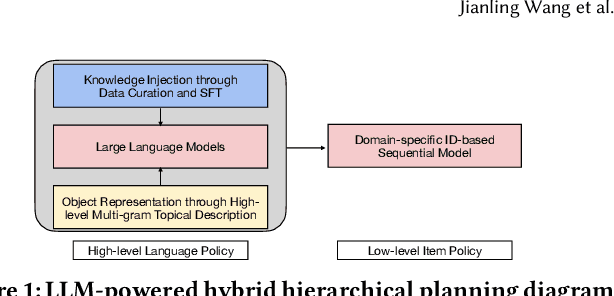
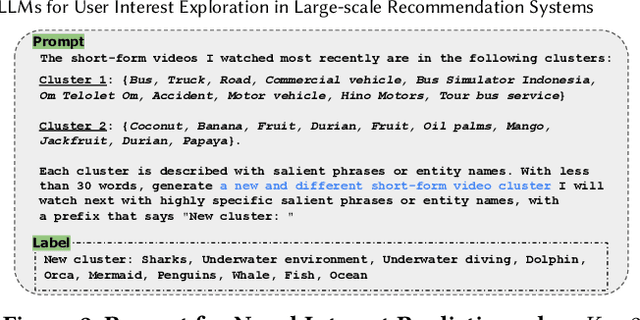
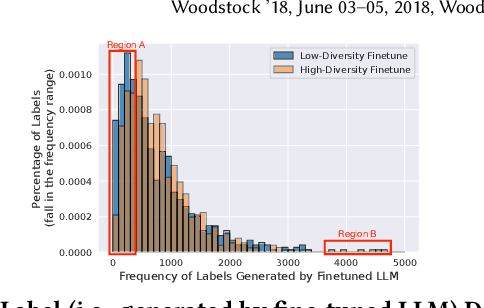

Abstract:Traditional recommendation systems are subject to a strong feedback loop by learning from and reinforcing past user-item interactions, which in turn limits the discovery of novel user interests. To address this, we introduce a hybrid hierarchical framework combining Large Language Models (LLMs) and classic recommendation models for user interest exploration. The framework controls the interfacing between the LLMs and the classic recommendation models through "interest clusters", the granularity of which can be explicitly determined by algorithm designers. It recommends the next novel interests by first representing "interest clusters" using language, and employs a fine-tuned LLM to generate novel interest descriptions that are strictly within these predefined clusters. At the low level, it grounds these generated interests to an item-level policy by restricting classic recommendation models, in this case a transformer-based sequence recommender to return items that fall within the novel clusters generated at the high level. We showcase the efficacy of this approach on an industrial-scale commercial platform serving billions of users. Live experiments show a significant increase in both exploration of novel interests and overall user enjoyment of the platform.
Large Language Models as Data Augmenters for Cold-Start Item Recommendation
Feb 18, 2024


Abstract:The reasoning and generalization capabilities of LLMs can help us better understand user preferences and item characteristics, offering exciting prospects to enhance recommendation systems. Though effective while user-item interactions are abundant, conventional recommendation systems struggle to recommend cold-start items without historical interactions. To address this, we propose utilizing LLMs as data augmenters to bridge the knowledge gap on cold-start items during training. We employ LLMs to infer user preferences for cold-start items based on textual description of user historical behaviors and new item descriptions. The augmented training signals are then incorporated into learning the downstream recommendation models through an auxiliary pairwise loss. Through experiments on public Amazon datasets, we demonstrate that LLMs can effectively augment the training signals for cold-start items, leading to significant improvements in cold-start item recommendation for various recommendation models.
Gemini: A Family of Highly Capable Multimodal Models
Dec 19, 2023Abstract:This report introduces a new family of multimodal models, Gemini, that exhibit remarkable capabilities across image, audio, video, and text understanding. The Gemini family consists of Ultra, Pro, and Nano sizes, suitable for applications ranging from complex reasoning tasks to on-device memory-constrained use-cases. Evaluation on a broad range of benchmarks shows that our most-capable Gemini Ultra model advances the state of the art in 30 of 32 of these benchmarks - notably being the first model to achieve human-expert performance on the well-studied exam benchmark MMLU, and improving the state of the art in every one of the 20 multimodal benchmarks we examined. We believe that the new capabilities of Gemini models in cross-modal reasoning and language understanding will enable a wide variety of use cases and we discuss our approach toward deploying them responsibly to users.
Beyond ChatBots: ExploreLLM for Structured Thoughts and Personalized Model Responses
Dec 01, 2023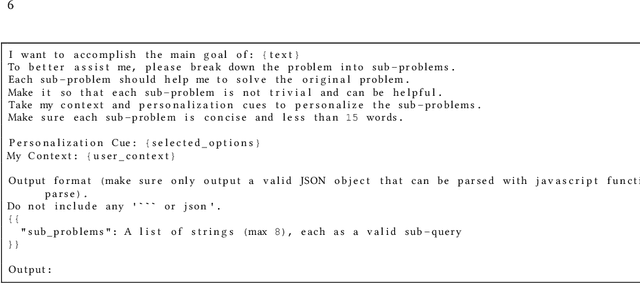
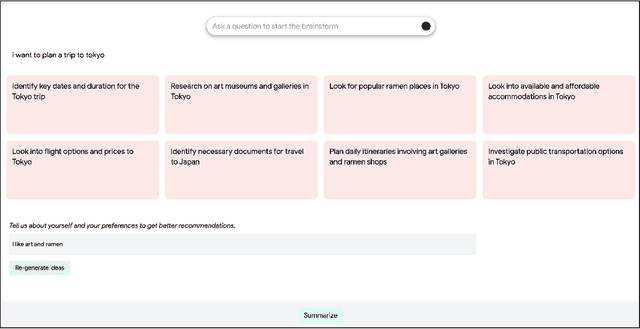
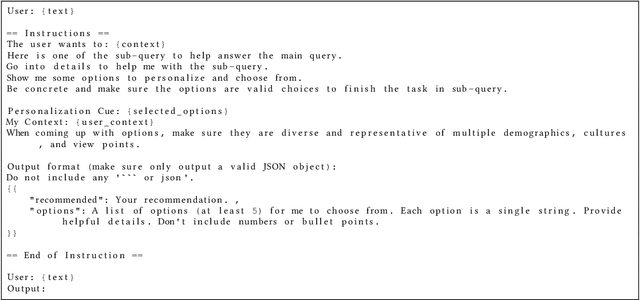

Abstract:Large language model (LLM) powered chatbots are primarily text-based today, and impose a large interactional cognitive load, especially for exploratory or sensemaking tasks such as planning a trip or learning about a new city. Because the interaction is textual, users have little scaffolding in the way of structure, informational "scent", or ability to specify high-level preferences or goals. We introduce ExploreLLM that allows users to structure thoughts, help explore different options, navigate through the choices and recommendations, and to more easily steer models to generate more personalized responses. We conduct a user study and show that users find it helpful to use ExploreLLM for exploratory or planning tasks, because it provides a useful schema-like structure to the task, and guides users in planning. The study also suggests that users can more easily personalize responses with high-level preferences with ExploreLLM. Together, ExploreLLM points to a future where users interact with LLMs beyond the form of chatbots, and instead designed to support complex user tasks with a tighter integration between natural language and graphical user interfaces.
Better Generalization with Semantic IDs: A case study in Ranking for Recommendations
Jun 13, 2023Abstract:Training good representations for items is critical in recommender models. Typically, an item is assigned a unique randomly generated ID, and is commonly represented by learning an embedding corresponding to the value of the random ID. Although widely used, this approach have limitations when the number of items are large and items are power-law distributed -- typical characteristics of real-world recommendation systems. This leads to the item cold-start problem, where the model is unable to make reliable inferences for tail and previously unseen items. Removing these ID features and their learned embeddings altogether to combat cold-start issue severely degrades the recommendation quality. Content-based item embeddings are more reliable, but they are expensive to store and use, particularly for users' past item interaction sequence. In this paper, we use Semantic IDs, a compact discrete item representations learned from content embeddings using RQ-VAE that captures hierarchy of concepts in items. We showcase how we use them as a replacement of item IDs in a resource-constrained ranking model used in an industrial-scale video sharing platform. Moreover, we show how Semantic IDs improves the generalization ability of our system, without sacrificing top-level metrics.
Value of Exploration: Measurements, Findings and Algorithms
May 12, 2023



Abstract:Effective exploration is believed to positively influence the long-term user experience on recommendation platforms. Determining its exact benefits, however, has been challenging. Regular A/B tests on exploration often measure neutral or even negative engagement metrics while failing to capture its long-term benefits. To address this, we present a systematic study to formally quantify the value of exploration by examining its effects on the content corpus, a key entity in the recommender system that directly affects user experiences. Specifically, we introduce new metrics and the associated experiment design to measure the benefit of exploration on the corpus change, and further connect the corpus change to the long-term user experience. Furthermore, we investigate the possibility of introducing the Neural Linear Bandit algorithm to build an exploration-based ranking system, and use it as the backbone algorithm for our case study. We conduct extensive live experiments on a large-scale commercial recommendation platform that serves billions of users to validate the new experiment designs, quantify the long-term values of exploration, and to verify the effectiveness of the adopted neural linear bandit algorithm for exploration.
Do LLMs Understand User Preferences? Evaluating LLMs On User Rating Prediction
May 10, 2023Abstract:Large Language Models (LLMs) have demonstrated exceptional capabilities in generalizing to new tasks in a zero-shot or few-shot manner. However, the extent to which LLMs can comprehend user preferences based on their previous behavior remains an emerging and still unclear research question. Traditionally, Collaborative Filtering (CF) has been the most effective method for these tasks, predominantly relying on the extensive volume of rating data. In contrast, LLMs typically demand considerably less data while maintaining an exhaustive world knowledge about each item, such as movies or products. In this paper, we conduct a thorough examination of both CF and LLMs within the classic task of user rating prediction, which involves predicting a user's rating for a candidate item based on their past ratings. We investigate various LLMs in different sizes, ranging from 250M to 540B parameters and evaluate their performance in zero-shot, few-shot, and fine-tuning scenarios. We conduct comprehensive analysis to compare between LLMs and strong CF methods, and find that zero-shot LLMs lag behind traditional recommender models that have the access to user interaction data, indicating the importance of user interaction data. However, through fine-tuning, LLMs achieve comparable or even better performance with only a small fraction of the training data, demonstrating their potential through data efficiency.
Large Language Models Can Be Easily Distracted by Irrelevant Context
Feb 13, 2023



Abstract:Large language models have achieved impressive performance on various natural language processing tasks. However, so far they have been evaluated primarily on benchmarks where all information in the input context is relevant for solving the task. In this work, we investigate the distractibility of large language models, i.e., how the model problem-solving accuracy can be influenced by irrelevant context. In particular, we introduce Grade-School Math with Irrelevant Context (GSM-IC), an arithmetic reasoning dataset with irrelevant information in the problem description. We use this benchmark to measure the distractibility of cutting-edge prompting techniques for large language models, and find that the model performance is dramatically decreased when irrelevant information is included. We also identify several approaches for mitigating this deficiency, such as decoding with self-consistency and adding to the prompt an instruction that tells the language model to ignore the irrelevant information.
Rationale-Augmented Ensembles in Language Models
Jul 02, 2022



Abstract:Recent research has shown that rationales, or step-by-step chains of thought, can be used to improve performance in multi-step reasoning tasks. We reconsider rationale-augmented prompting for few-shot in-context learning, where (input -> output) prompts are expanded to (input, rationale -> output) prompts. For rationale-augmented prompting we demonstrate how existing approaches, which rely on manual prompt engineering, are subject to sub-optimal rationales that may harm performance. To mitigate this brittleness, we propose a unified framework of rationale-augmented ensembles, where we identify rationale sampling in the output space as the key component to robustly improve performance. This framework is general and can easily be extended to common natural language processing tasks, even those that do not traditionally leverage intermediate steps, such as question answering, word sense disambiguation, and sentiment analysis. We demonstrate that rationale-augmented ensembles achieve more accurate and interpretable results than existing prompting approaches--including standard prompting without rationales and rationale-based chain-of-thought prompting--while simultaneously improving interpretability of model predictions through the associated rationales.
 Add to Chrome
Add to Chrome Add to Firefox
Add to Firefox Add to Edge
Add to Edge